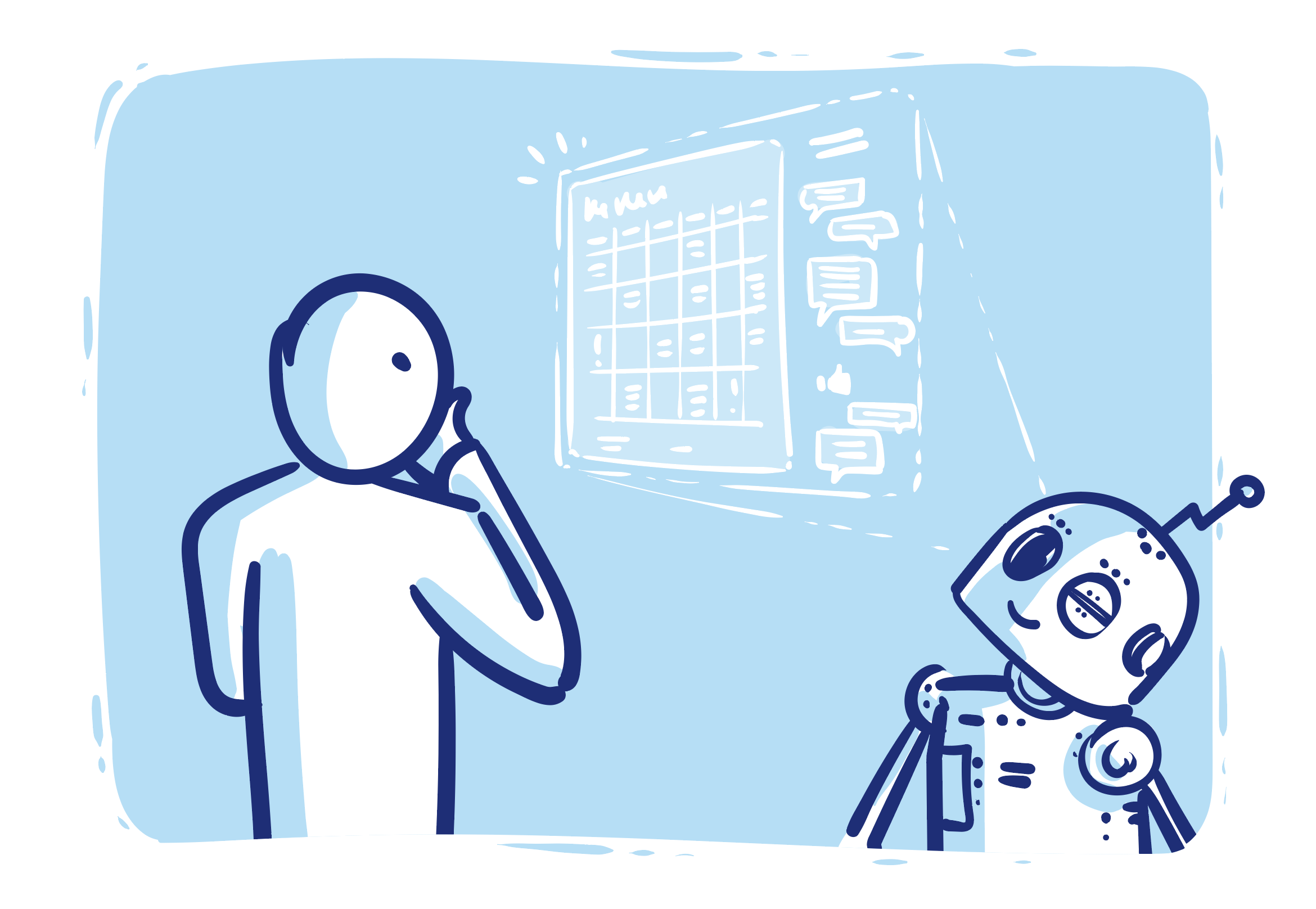Navigating the complexities of insurance choices can be overwhelming, but AI-driven chatbots, powered by Large Language Models (LLM), offer a transformative solution. These chatbots engage users in personalized conversations, simplifying the selection process across various channels. Sollers Consulting, at the forefront of innovation, ensures the efficiency and reliability of these chatbots through meticulous tuning, security measures, and a human-in-the-loop approach for to critical decisions. As leaders in the field, we prioritize optimizing insurance chatbots, providing clients with a seamless and secure experience.

The role of insurance chatbots in customer journey
Choosing the right insurance can feel like a bottomless pit of confusion. There are so many plans, rules, and conditions that it’s easy to get lost in the jumble. It’s like trying to solve a puzzle without all the pieces. That’s where talking to an insurance expert usually comes in handy, as they can guide you through the maze of options.
Tasks that involve repetitive, simple, and frequently used actions can incur significant costs when performed by humans. But now, there’s something new and exciting happening: the rise of smart assistants, like friendly robots that help you with your insurance choices. These clever little helpers, powered by Artificial Intelligence (AI), are making the whole process much simpler.
In the fascinating world of AI-powered insurance chatbots, there’s a revolutionary way they guide us through the complicated process. AI chatbots engage in interactive conversations, making the insurance selection process feel more like a friendly chat than a daunting task. They gently inquire about your preferences, your lifestyle, and any unique circumstances that might impact your insurance needs. It’s not just collecting information – it’s processing it in real time to provide you with personalized recommendations. Utilizing your input, the chatbot can navigate through numerous insurance options and customize a plan that precisely suits your requirements.
Chatbots in insurance can be deployed across various channels, including websites, WhatsApp, Facebook Messenger, SMS, or through dedicated chat tools embedded in webpages.
What are the benefits of using Insurance chatbots
Chatbots are one of the examples of insurance AI automation. Implementing them in customer service can significantly enhance the overall customer experience by addressing various needs and scenarios. Firstly, the availability of chatbots 24/7 ensures that customers can receive assistance at any time, serving a global audience across different time zones. This constant availability promotes customer satisfaction and engagement, as users can get immediate responses to their queries.
Moreover, insurance chatbots excel in handling routine and repetitive tasks, freeing up human support agents to focus on more complex and intricate cases. For example, an insurance AI chatbot can automate processes like insurance claims, provide product information, or process simple transactions. Not only does this increase operational efficiency, but it also allows human agents to apply their expertise to cases that require a personalized touch, ultimately elevating the quality of customer interactions.
Additionally, chatbots excel in guiding customers through troubleshooting processes and FAQs, offering instant solutions to common problems. This speeds up issue resolution and provides customers with quick and accessible information.
What drives the enchantment beneath the surface
At their computational core, AI chatbots leverage state-of-the-art algorithms, often fueled by Large Language Models (LLM), to process vast datasets. Having been exposed to a variety of linguistic patterns, these models exceed simple script-based interactions. They immerse themselves in the nuances of human language, enabling them to interpret an input, decipher nuanced intent, and respond dynamically—a testament to the power of NLP (Natural Language Processing) in understanding and contextualizing language intricacies.
Embracing the advanced capabilities of chatbots for insurance agents like Amazon Lex, Google Dialogflow, and IBM Watson not only streamlines routine tasks but also involves savvy configuration, meticulous dialog crafting, and seamless integration with other systems and databases. Conversational AI for insurance enables call center professionals to shift focus to complex problem-solving and personalized interactions.
Moreover, leveraging cutting-edge LLM models, which are gaining immense popularity nowadays, adds an extra layer of sophistication, allowing conversations to be even more finely tuned to meet the diverse needs of customers, further enhancing the overall customer experience with a blend of efficiency and contemporary advancements.
What are the challenges of implementing insurance chatbots
Navigating the realm of AI-driven conversations introduces a critical question: can engaging in dialogue with automated chatbot for insurance company guarantee safety and security?
The prevalent concern stems from the information circulating about insurance conversational AI potentially generating inaccurate or misleading responses. The worry here is that such variances might lead customers wrong, potentially providing incorrect information or casting insurance companies in an unfavorable light.
Chat interfaces may be employed to seek support or information for activities that are considered unethical by certain individuals
The evolving regulatory landscape may be worrying in the context of LLM systems aligning with data protection laws. Concerns arise regarding the privacy and security implications associated with LLMs’ acquisition and management of sensitive data. The use of LLMs in a public cloud environment results in the possibility of unauthorized access to data, leading to potential legal non-compliance and damage to reputation.

How to properly implement insurance AI chatbots and ensure quality of answers
Several strategies can be employed to mitigate the risks associated with discussed earlier concerns.
- Improving how the AI insurance chatbot model works involves careful adjustment using good-quality and diverse datasets. It’s like teaching the model by exposing it to various types of language and user questions. This process helps the model better understand and respond accurately to a wide range of inputs. We start with datasets that are well-prepared, ensuring they cover many ways people might express themselves. These datasets are like a training ground for the model to learn and understand various language patterns and user queries.
- Diverse datasets introduce the model to different ways people talk, including cultural differences and unique ways of interacting. This exposure helps the conversational ai model become flexible, so it can handle a variety of inputs and understand the needs of different users.
- The adjustment process is ongoing and adaptable. We learn from how the model performs, making changes as needed. It’s a bit like modifying a recipe based on feedback—this way, the model keeps getting better at understanding and responding to users as language and interactions evolve.
- Security gates for user queries act as filters for incoming requests. Before a user’s question reaches the AI system, it passes through this gate, which scrutinizes the input for any potential security threats or malicious intent. This initial checkpoint helps identify and block suspicious queries, safeguarding the system from potential vulnerabilities.
- Similarly, security gates are implemented for the responses generated by the AI chatbot system. Before a system-generated answer is delivered to the user, it undergoes thorough examination at the response security gate. This scrutiny ensures that the automated responses align with established company policy, preventing the inadvertent disclosure of sensitive information or the generation of inappropriate content.
- As the conversation progresses, historical data from the ongoing interaction is continuously accumulated. This includes details about the current session, specific queries raised, and any additional context provided by the user. By incorporating this real-time information, the system gains a dynamic understanding of the evolving conversation, ensuring that responses remain relevant and coherent. During interactions with the insurance chatbots, fundamental information regarding the current policy or the history of claims can be seamlessly integrated into the ongoing session. A more comprehensive understanding of user preferences and context contributes to an improved overall user experience. Augmenting requests with historical data ensures that the system engages in conversations that feel natural, relevant, and tailored to the individual user, fostering a sense of continuity and personalized interaction.
- Introducing a human-in-the-loop is crucial for critical decision-making scenarios. In situations that demand nuanced understanding, empathy, or ethical considerations, human judgment plays an irreplaceable role in ensuring the appropriateness of responses. The human-in-the-loop serves as a fail-safe mechanism, especially for handling unique or sensitive cases. This intervention guarantees that decisions align with ethical standards, legal requirements, and user expectations, mitigating potential risks associated with purely automated responses.
Get the most out of conversational AI in insurance
In conclusion, the utilization of insurance chatbots, especially those leveraging advanced technologies, offers tremendous potential in streamlining processes, optimizing costs, and providing personalized assistance in complex domains like insurance. While their benefits are evident, it’s crucial to recognize the importance of careful configuration and model tuning to mitigate potential risks associated with getting ‘out of the box.’
Sollers Consulting stands at the forefront of this transformative landscape. With several successful beyond conventional approaches, we continue to innovate and develop techniques that not only enhance the efficiency of these systems, but also ensure their reliability and security.Sollers Consulting remains committed to pushing the boundaries, ensuring our clients harness the full potential of insurance chatbots while maintaining a vigilant eye on best practices and risk mitigation. Contact us to determine which solution will be the best for you.

Mariusz Kaczor – IT Architect at Sollers Consulting
Mariusz Kaczor is an IT Architect with 20 years of experience, pioneering neural networks since the outset of his career. With 8-year proficiency in Guidewire, specializing in insurance software solutions, Mariusz seamlessly integrates diverse systems, demonstrating leadership and adaptability. His commitment to staying at the forefront of technology defines him as a forward-thinking professional shaping the future of IT architecture.
